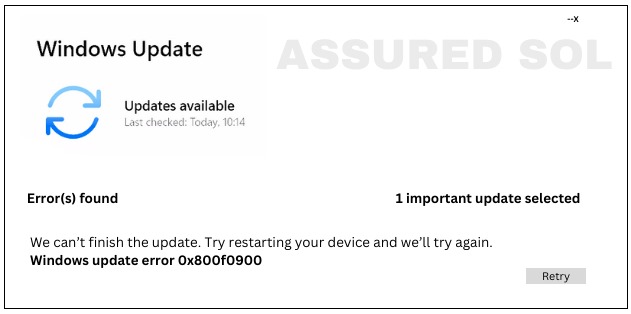error code 0x800f0900
How to Fix Windows Error Code 0x800f0900
Encountering error code 0x800f0900 on Windows systems often signifies a problem during the Windows Update process. This error can occur due to various reasons, including corrupted system files, conflicts with third-party software, or issues with the update database.
Causes of Error Code 0x800f0900:
- Corrupted System Files: If certain system files essential for updates are damaged or missing, it can trigger this error.
- Interference from Third-Party Software: Security software or other applications might interfere with the update process, leading to this error.
- Update Database Issues: Problems with the update database or services responsible for managing updates can also cause error 0x800f0900.
Resolving Windows Error Code 0x800f0900:
Run Windows Update Troubleshooter:
Use the built-in Windows Update Troubleshooter to automatically detect and fix common update-related issues.
Check Internet Connection:
Ensure a stable internet connection. A poor connection might disrupt the update process.
Disable Third-Party Software:
Temporarily disable antivirus or firewall software before attempting updates. Sometimes, these programs can interfere with the update process.
Run DISM and SFC Scans:
Use Deployment Image Service and Management Tool (DISM) and System File Checker (SFC) to repair corrupted system files. Open Command Prompt as an administrator and run:
- DISM.exe /Online /Cleanup-image /Restorehealth
- Followed by
- sfc /scannow
Clear Update Cache:
- Stop the Windows Update service, delete the contents of the Software Distribution folder (located in C:\Windows), then restart the service.
- This action forces Windows to rebuild the update cache.
- Press Win + R to open the Run dialog.
- Type “cmd” and press Enter to open the Command Prompt.
- In the Command Prompt, type “ipconfig /flushdns” and press Enter to flush DNS cache.
Perform a Clean Boot:
Disable all non-essential startup services and programs using the System Configuration tool (msconfig), then attempt the update process again.
- Performing a clean boot in Windows helps troubleshoot software conflicts. Here’s how to do it:
- Open System Configuration: Press Windows + R, type msconfig, then hit Enter.
- Access System Configuration: Go to the “Services” tab and check “Hide all Microsoft services.” Click “Disable all.”
- Startup Items: Go to the “Startup” tab and select “Open Task Manager.” Disable all startup items one by one.
- Apply Changes: Click “OK” in the System Configuration window, then “Restart” when prompted.
- Test: After restarting, check if the issue persists. If not, gradually enable services/startup items to identify the culprit.
Seek Expert Assistance:
If none of the above methods resolve the issue, consider seeking help from Microsoft Support or a professional technician who specializes in Windows-related problems.
Conclusion:
Error code 0x800f0900 during Windows Update can be frustrating, but troubleshooting steps like using built-in tools, checking system files, and managing third-party software can often resolve the issue. Patience and persistence in applying these solutions can help in successfully overcoming this error and ensuring a smoothly updated Windows system.
Remember to back up essential data before attempting any major system changes or updates to prevent potential data loss.

